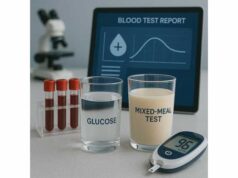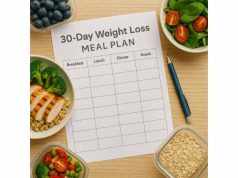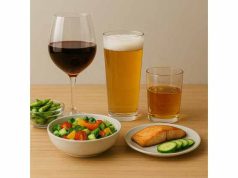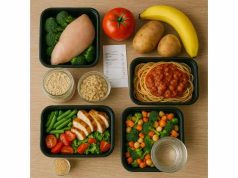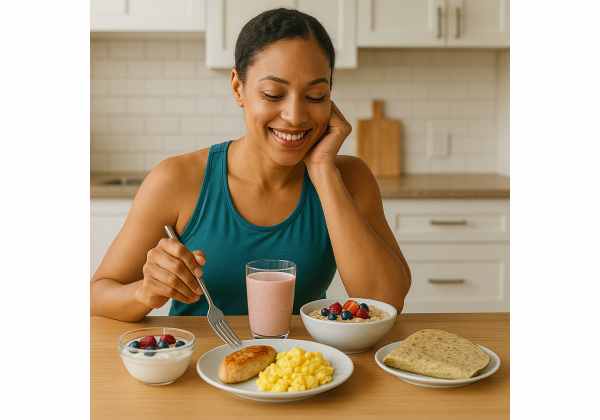
Breakfast can make weight loss easier when it solves the real problem—morning hunger that snowballs into afternoon cravings. The fix is not a smaller muffin; it is a meal that delivers protein, fiber, and steady energy without slowing you down. This guide shows you how to set simple breakfast targets, assemble fast meals from pantry staples, and prep make-ahead options for busy weeks. If you want a quick refresher on calories, protein, carbs, and how breakfast fits the bigger picture, skim our primer on weight loss nutrition fundamentals. Then come back here and use the templates and ideas below to build a breakfast you can repeat.
Table of Contents
- Breakfast for weight loss: what works
- Build a high-protein breakfast
- 15 quick high-protein ideas
- Make-ahead breakfasts that save time
- Carbs, fiber and fullness
- Breakfast timing and workouts
- Troubleshooting common breakfast mistakes
- Frequently Asked Questions
Breakfast for weight loss: what works
A good breakfast is not small; it is strategic. It should curb hunger for hours, support your training or morning workload, and help you stay in a modest calorie deficit without white-knuckling. That means prioritizing protein, fiber, fluid volume, and measured fats.
Targets that keep you full
- Protein: 25–40 g at breakfast. This stabilizes appetite and protects lean mass.
- Fiber: 8–12 g from fruit, oats, whole grains, or beans.
- Carbs: quality first (oats, fruit, potatoes, whole-grain bread, beans). Quantity depends on your daily calories and activity.
- Fats: small but present—1–2 teaspoons oil, nuts, or seeds for flavor and absorption.
Why it works
Protein and fiber slow digestion, while water-rich foods (fruit, vegetables, oats) add volume. Your stomach stretches, your brain registers fullness, and you feel in control by mid-morning. Contrast that with a pastry and latte combo: fast carbs and fat, little protein, and hunger by 10:30.
What to keep simple
- Coffee and tea are fine. Keep syrups and creamers modest; milk or a splash of half-and-half is easier to budget.
- Liquid calories creep. Smoothies can be great, but measure nut butter, honey, and juice.
- Savoriness helps. Many people report fewer afternoon cravings after a savory breakfast (eggs, tofu, cottage cheese) than after a sweet one.
Build a small rotation
Pick two weekday options and one weekend option you like. Repetition lowers friction and gives you consistent portions to work with. If you want a quick overview of pacing and safe expectations while you dial in breakfast, browse our concise guide to safe weight loss basics.
A sample “goldilocks” plate
- 2 eggs plus 150 g egg whites scrambled with spinach and salsa
- 1 slice high-fiber toast or a small potato
- 170 g Greek yogurt on the side with berries and chia
Protein lands near 35–40 g, fiber near 10–12 g, and you are satisfied until lunch.
Build a high-protein breakfast
You do not need recipes; you need frameworks. Use the templates below to assemble breakfast in five minutes, then adjust portion sizes to match your calorie range.
The three-part template
- Protein anchor (25–40 g): eggs or egg whites, Greek yogurt or skyr, cottage cheese, tofu or tempeh, canned fish, whey or soy isolate.
- High-fiber carb (20–45 g): oats, fruit, whole-grain bread, potatoes, leftover beans or lentils, high-fiber tortillas.
- Flavor and fats (1–2 teaspoons): olive oil, nuts, seeds, peanut butter, or tahini; herbs, salsa, spices, lemon.
Five-minute builds
- Yogurt bowl: 200–250 g Greek yogurt + ½ cup oats + 1 cup berries + 1 tablespoon chia.
- Egg and potato skillet: 2 eggs + 150 g egg whites scrambled over a small pre-cooked potato cube; finish with salsa.
- Tofu breakfast wrap: crisp 150–200 g firm tofu in a nonstick pan; tuck into a high-fiber tortilla with slaw and hot sauce.
- Cottage cheese toast: 200 g cottage cheese on whole-grain toast with tomatoes, pepper, and a teaspoon olive oil.
Portion control without tracking
- Protein = palm to palm-and-a-half.
- Oats or cooked grains = ½–1 cupped hand.
- Fruit = one fist.
- Oils and nut butter = one thumb (1 teaspoon) to keep calories honest.
Adjust for different goals
- If training early: add 20–30 g fast carbs (banana, toast).
- If sedentary mornings: push more vegetables; keep carbs nearer 20–30 g.
- If hunger lingers: increase protein by 10–15 g before adding calories elsewhere.
For exact daily protein targets by body size and activity, see our quick guide to daily protein targets. Use those numbers to size your breakfast anchor and keep meals consistent.
Batch once, assemble all week
- Pre-cook potatoes or barley for fast sides.
- Keep a container of chopped vegetables for quick scrambles.
- Mix a big jar of “topping blend” (chia, ground flax, crushed nuts) and use 1 tablespoon per bowl.
15 quick high-protein ideas
Below are 15 breakfasts you can assemble in 5–10 minutes. Protein estimates are approximate; adjust portions to your targets. Use store brands and frozen fruit or vegetables for speed and cost control.
- Greek yogurt power bowl — 250 g Greek yogurt, ½ cup oats, berries, 1 tablespoon chia. ~35–40 g protein.
- Egg and white scramble — 2 whole eggs + 150 g egg whites with spinach and salsa; small potato or toast. ~35–40 g.
- Tofu skillet wrap — 200 g firm tofu crisped with soy and spices, folded into a high-fiber tortilla with slaw. ~28–32 g.
- Cottage cheese fruit crunch — 250 g cottage cheese, apple or pear, cinnamon, 1 tablespoon crushed walnuts. ~28–32 g.
- Smoked salmon toast — whole-grain toast, 85 g smoked salmon, whipped cottage cheese or skyr, tomato, capers. ~25–30 g.
- Overnight oats plus yogurt — equal parts oats and milk, stirred with 150 g Greek yogurt and frozen berries. ~25–30 g.
- Protein oatmeal upgrade — cook oats with milk; whisk in 20–25 g whey or soy isolate off heat; add banana slices. ~30–35 g.
- Egg-in-a-mug — 2 eggs + 120 g egg whites, diced vegetables, cheese sprinkle; microwave 90–120 seconds; wrap in tortilla. ~35–40 g.
- Breakfast burrito — black beans, egg whites, salsa, and potatoes in a high-fiber tortilla; yogurt drizzle. ~30–35 g.
- Savory yogurt bowl — 250 g Greek yogurt topped with cucumber, tomatoes, herbs, olive oil teaspoon, and a slice of whole-grain toast. ~30–35 g.
- High-protein chia pudding — chia soaked in milk, folded with 200 g skyr and berries. ~28–32 g.
- Cottage cheese pancakes — blitz cottage cheese, oats, egg whites; griddle small pancakes; top with fruit compote. ~30–35 g.
- Tuna breakfast toast — canned tuna mixed with yogurt, lemon, and pepper on toast with cucumber. ~30–35 g.
- Tempeh and greens — sauté tempeh strips with garlic; plate with leftover potatoes and tomatoes. ~25–30 g.
- Simple smoothie that holds — 200–250 ml milk, 30 g whey or soy isolate, 1 cup frozen berries, 1 tablespoon chia; blend thick and drink slowly. ~30–35 g.
Make any idea more filling
- Add ½–1 cup beans or lentils to savory plates.
- Top bowls with extra vegetables (grated carrot, shredded cabbage, peppers).
- Swap refined bread for high-fiber toast.
For more options and serving sizes to plug into these ideas, keep our concise protein foods list handy. It makes substitutions simple without changing your protein total.
Time-saving rhythm
- Keep one “sweet” option (oats or yogurt) and one “savory” option (eggs or tofu) on repeat.
- Prep two sauces weekly (salsa verde; yogurt-tahini). Flavor makes repetition easy without creeping calories.
Make-ahead breakfasts that save time
When mornings are hectic, batch a base and finish with fresh toppings in under two minutes. The goal is to front-load effort once so weekday choices are automatic.
Four reliable make-aheads
- Overnight oats matrix (4 jars): oats + milk + a spoon of chia in each jar. In the morning, add 150–200 g Greek yogurt and fruit. Rotate flavors with cinnamon, cocoa, or lemon zest.
- Egg bake (12 squares): whisk eggs and egg whites with chopped vegetables; bake in a sheet pan. Reheat two squares and serve with salsa and toast.
- Freezer burritos (8 wraps): scramble egg whites with beans and vegetables; roll into high-fiber tortillas; freeze. Reheat in a dry pan or air fryer for crisp edges.
- Protein pancakes (16 minis): cottage cheese, oats, and egg whites blended and griddled. Freeze; reheat in a toaster. Top with fruit compote or skyr.
Keep texture and taste high
- Cool batches quickly to avoid sogginess.
- Store sauces separately and add just before eating.
- Finish hot plates with acid (lemon, vinegar) and herbs.
Shelf-stable backups
- Canned fish, high-fiber tortillas, oats, and long-life milk make “no-fresh-produce” mornings stress-free.
- Single-serve yogurts are more expensive, but one sleeve in the fridge can save a drive-through stop.
If you like a structured weekend routine, our one-hour weekend meal prep shows how to cook once and assemble fast breakfasts and dinners all week.
Carbs, fiber and fullness
Carbs at breakfast are not the enemy; low-fiber, low-protein carbs are. Choose sources that bring fiber and water so calorie-for-calorie you feel more satisfied.
Best breakfast carbs
- Oats: versatile, budget-friendly, easy to enrich with protein.
- Fruit: berries, apples, pears, citrus, and bananas offer water and fiber in tidy portions.
- Potatoes with skin: high satiety per calorie; excellent with eggs or tofu.
- Whole-grain bread or tortillas: look for ≥3 g fiber per slice or ≥8 g per tortilla.
- Leftover legumes or intact grains: beans, lentils, barley, or quinoa fold into scrambles and bowls.
Simple portioning
- Oats: ½–¾ cup dry for most people.
- Toast: one slice with protein; two if training early.
- Potatoes: small fist-size per person at sedentary mornings; bigger on training days.
Upgrade the sweet tooth
- Choose fruit as the sweet element, not honey or juice.
- Add cinnamon, cocoa, or vanilla to oats and yogurt for dessert-level flavor without extra sugar.
Fiber goals without bloat
Aim for 8–12 g fiber at breakfast and 25–38 g/day overall. Increase gradually and drink water. If you need easy swaps to raise fiber without changing your meals much, see our quick list of daily fiber targets and simple swaps.
Breakfast timing and workouts
You do not need perfect timing, but you will feel better if breakfast supports your training and workday.
If you train early
- Keep it light before: banana or toast plus yogurt or a small shake (20–25 g protein).
- Eat a fuller meal after: 25–40 g protein and 30–60 g carbs within a few hours (eggs and potatoes; yogurt bowl and toast).
If you train at lunch
- Breakfast should be protein-forward with moderate carbs (oats and yogurt; eggs and toast).
- Add 20–30 g carbs 45–60 minutes pre-workout if sessions are intense.
If you prefer to delay breakfast
Intermittent fasting can work if the total day still hits protein and calories. Break the fast with a protein-rich meal to avoid overcompensating later. For a balanced overview of schedules like 16/8 or 14/10, see our guide to intermittent fasting basics.
Work mornings with long meetings
- Eat a portable option (burrito, yogurt bowl in a jar).
- Keep an “emergency” kit: shelf-stable milk, whey or soy isolate, oats, canned tuna, high-fiber tortillas.
Hydration, caffeine, and appetite
- Coffee and tea are fine; keep sugar minimal and milk measured.
- Thirst can feel like hunger: start the day with water or sparkling water alongside breakfast.
Troubleshooting common breakfast mistakes
If mornings derail you, the answer is rarely “eat less.” Fix the structure and the problem fades.
Mistake 1: Coffee only, then a 10 a.m. pastry
You start a calorie debt and chase it with fast carbs.
Fix: a 250–350 calorie protein-first breakfast (yogurt bowl; egg-and-white scramble) prevents the crash and reduces afternoon snacking.
Mistake 2: Smoothies that sip like dessert
Fruit, juice, honey, and nut butter add up quickly.
Fix: anchor with 30 g whey or soy isolate, 1 cup berries, milk or soy milk, and 1 tablespoon chia. Blend thick and drink slowly.
Mistake 3: “Healthy” toast with avocado and no protein
Tasty, but light on protein and easy to over-portion fats.
Fix: add 200–250 g cottage cheese or 2 eggs and measure avocado to ¼–½ fruit.
Mistake 4: Cereal bowls that vanish
Low fiber, low protein, high speed.
Fix: switch to oats plus yogurt, or cereal as a crunch topping on a Greek-yogurt base.
Mistake 5: Weekend brunch blowouts
Huge portions and sugary drinks can wipe out a week’s deficit.
Fix: keep the protein anchor and order a vegetable side; share pancakes; keep drinks simple.
Mistake 6: Prep paralysis
You skip breakfast because you did not prep.
Fix: pick one make-ahead (egg bake, overnight oats, or freezer burritos). Success comes from repetition, not novelty.
If you want to audit broader habits that might stall progress, our checklist on common diet mistakes can help you pinpoint where to adjust without overhauling your routine.
Frequently Asked Questions
How much protein should breakfast include for weight loss?
Aim for 25–40 grams. Most people feel best near 30–35 grams, paired with 8–12 grams of fiber. That combination reduces mid-morning cravings and makes it easier to stay within your daily calories.
Is skipping breakfast bad for weight loss?
Not necessarily. Some do well with a delayed first meal. What matters is your daily protein and calories. If skipping breakfast leads to overeating later, add a simple protein-rich meal in the morning.
Can I eat carbs at breakfast and still lose weight?
Yes. Choose high-fiber carbs like oats, fruit, whole-grain bread, potatoes, or beans. Keep portions moderate and pair them with 25–40 g protein to steady appetite and support a calorie deficit.
Are smoothies good breakfast options?
They can be, if built well. Anchor with 30 g whey or soy isolate, add fruit for fiber, include chia or flax, and measure calorie-dense add-ins. Blend thick and sip slowly to increase fullness.
What is the fastest balanced breakfast I can make?
Two options in five minutes:
- 250 g Greek yogurt, oats, berries, and chia.
- 2 eggs plus 150 g egg whites with spinach and salsa, wrapped in a high-fiber tortilla. Both deliver ~30–40 g protein.
How do I meal prep breakfasts for the week?
Pick one base: overnight oats, an egg bake, or freezer burritos. Batch on Sunday, store portions, and add fresh fruit or salsa each morning. Consistency beats variety when time is tight.
References
- Systematic review and meta-analysis of protein intake to support muscle mass and function in healthy adults 2022 (Systematic Review)
- A dairy-based, protein-rich breakfast enhances satiety and cognitive concentration before lunch in overweight to obese young females: A randomized controlled cross-over study 2024 (RCT)
- Calorie Restriction with or without Time-Restricted Eating in Weight Loss 2022 (RCT)
- Eating versus skipping breakfast has no discernible effect on obesity-related anthropometric outcomes: a systematic review and meta-analysis 2021 (Systematic Review)
Disclaimer
This article provides general nutrition education. It is not a substitute for personalized medical advice, diagnosis, or treatment. If you have diabetes, kidney disease, allergies, are pregnant or breastfeeding, or have a history of disordered eating, consult a qualified healthcare professional before changing your diet.
If this guide helped you, please share it with a friend who wants easier mornings, and consider following us on Facebook, X, or whichever network you use for calm, practical nutrition tips and weekly meal ideas.

